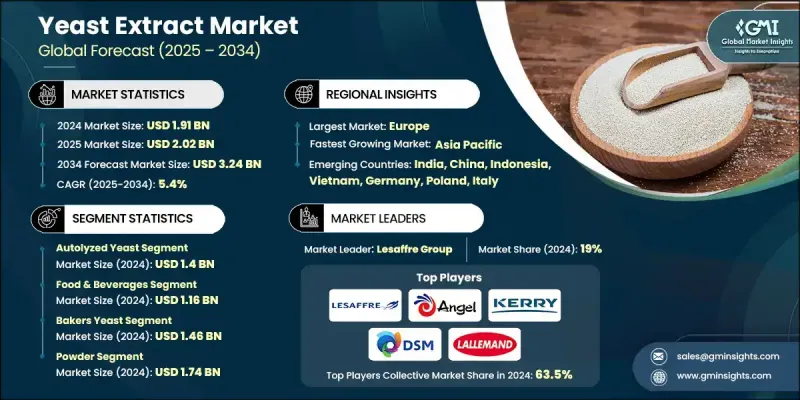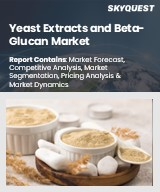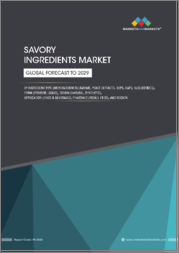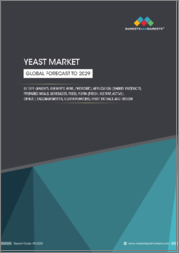
|
시장보고서
상품코드
1844325
효모 추출물 시장 기회, 성장 촉진요인, 산업 동향 분석 및 예측(2025-2034년)Yeast Extract Market Opportunity, Growth Drivers, Industry Trend Analysis, and Forecast 2025 - 2034 |
||||||
세계의 효모 추출물 시장은 2024년에는 19억 1,000만 달러로 평가되었고, CAGR 5.4%로 성장하여 2034년에는 32억 4,000만 달러에 이를 것으로 예측됩니다.

주로 식품의 천연 성분과 클린 라벨 성분으로의 전환이 증가하면서 상승 추세를 주도하고 있습니다. 소비자들은 합성 첨가물, 특히 MSG와 같은 향미 조미료를 피하고 있으며, 식품 제조업체들은 더 건강하고 자연적인 대안으로 효모 추출물을 채택하고 있습니다. 풍부한 감칠맛으로 인공적인 성분을 사용하지 않고도 맛프로파일을 향상시킬 수 있습니다. 도시화와 라이프스타일의 변화로 가공식품과 조리식품의 인기가 높아짐에 따라 효모 추출물의 향미증진제 및 영양 첨가제로서의 역할이 점점 더 중요해지고 있습니다. 전 세계적으로 식품 가공 분야가 확대되고 식물성 식품과 건강 지향적 식품에 대한 관심이 높아지면서 효모 추출물은 수프, 소스, 스낵 등 다양한 용도로 수요가 증가하고 있습니다. 다양한 용도와 클린 라벨 처방과의 호환성으로 인해 건강 지향적 트렌드와 규제 요건을 모두 충족하고자 하는 식품 제조업체들이 선호하는 선택이 되었습니다.
| 시장 범위 | |
|---|---|
| 개시 연도 | 2024년 |
| 예측 연도 | 2025-2034년 |
| 시장 규모 | 19억 1,000만 달러 |
| 예측 금액 | 32억 4,000만 달러 |
| CAGR | 5.4% |
2024년 자가 용융 효모 부문은 14억 달러로 평가되었으며, 2025-2034년 연평균 5.6%의 성장률을 보일 것으로 예측됩니다. 분해 과정에서 향기로운 향미 성분을 자연적으로 방출하는 능력으로 클린 라벨 제제에서 유용하게 사용됩니다. 자연스러운 맛을 추구하는 소비자 수요가 증가함에 따라 조미료, 캐서롤, 소스에 자가 용해 효모의 사용은 지속적으로 증가하고 있습니다. 이 효모는 합성 첨가물에 의존하지 않고 맛을 향상시킬 수 있는 방법을 제조업체에 제공하여 진화하는 건강 트렌드와 라벨링에 대한 기대에 부응합니다.
음료 및 식품 부문은 2024년 11억 6,000만 달러로 시장 점유율 61%를 차지했고, 2034년까지 연평균 5.7%의 성장률을 보일 것으로 예측됩니다. 천연 감칠맛과 인공 첨가물 대체 능력은 수프, 조리된 음식, 스낵, 소스에서 특히 매력적입니다. 가공식품과 식물성 식습관이 꾸준히 증가함에 따라 효모 추출물은 맛과 건강 기준을 모두 충족하는 클린 라벨과 풍미 가득한 제제의 주요 성분으로 자리를 굳히고 있습니다.
미국 효모 추출물 시장은 2024년 3억 7,060만 달러로 평가되었으며, 2025-2034년 연평균 5.2% 성장할 것으로 예측됩니다. 북미, 특히 미국과 캐나다는 천연 식품 소재에 대한 성숙하면서도 증가하는 수요를 반영하고 있습니다. 소비자들이 건강 지향적인 간식이나 육류 및 합성 첨가물을 대체할 수 있는 식품을 선호함에 따라 효모 추출물은 수프, 소스, 육류가 없는 제품에 널리 사용되고 있습니다. 미국의 음료 및 식품 분야는 기술 혁신 속도가 빠르며 효모 추출물 솔루션을 위한 환경이 조성되어 있습니다.
세계 효모 추출물 산업을 주도하는 주요 기업은 다음과 같습니다. Thai Foods International Co. PAULA Ingredients,Agrano GmbH &Co.,Alltech,Synergy Flavors,Angel Yeast,Halcyon Proteins,Biorigin,Kerry Group,Kothari Fermentation &Biochem Ltd.,Lesaffre Group,Ohly,Biospringer,Oriental Yeast,Specialty Biotech。 효모 추출물 업계 기업들은 천연 발효 및 효소 기술에 투자함으로써 클린 라벨 트렌드에 부합하는 혁신을 우선시하고 있습니다. 많은 업체들이 유기농, 무알러지, 유전자 변형이 없는 효모 추출물을 포함한 제품 라인을 확대하며 건강을 중시하는 소비자 증가에 대응하고 있습니다. 식품 제조업체와의 전략적 제휴를 통해 특정 지역의 입맛과 식생활에 맞는 맞춤형 맛 솔루션을 제공할 수 있게 되었습니다. 각 업체들은 또한 수요 증가에 대응하기 위해 전 세계 유통망을 강화하고 제조 역량을 강화하고 있습니다.
목차
제1장 조사 방법
- 시장 범위와 정의
- 조사 디자인
- 조사 접근
- 데이터 수집 방법
- 데이터 마이닝 소스
- 세계
- 지역/국가
- 기본 추정과 계산
- 기준 연도 계산
- 시장 예측 주요 동향
- 1차 조사와 검증
- 1차 정보
- 예측 모델
- 조사 전제와 한계
제2장 주요 요약
제3장 업계 인사이트
- 생태계 분석
- 공급업체 상황
- 이익률
- 각 단계에서의 부가가치
- 밸류체인에 영향을 미치는 요인
- 파괴적 변화
- 업계에 대한 영향요인
- 성장 촉진요인
- 업계의 잠재적 리스크&과제
- 시장 기회
- 성장 가능성 분석
- 규제 상황
- 북미
- 유럽
- 아시아태평양
- 라틴아메리카
- 중동 및 아프리카
- Porter의 Five Forces 분석
- PESTEL 분석
- 가격 동향
- 지역별
- 제품별
- 향후 시장 동향
- 기술 및 혁신 상황
- 현재 기술 동향
- 신기술
- 특허 상황
- 무역 통계(HS코드)(주 : 무역 통계는 주요 국가에 한해 제공됩니다.)
- 주요 수입국
- 주요 수출국
- 지속가능성과 환경 측면
- 지속가능한 실천
- 폐기물 감축 전략
- 생산 에너지 효율
- 친환경 이니셔티브
- 탄소발자국 고려
제4장 경쟁 구도
- 서론
- 기업의 시장 점유율 분석
- 지역별
- 북미
- 유럽
- 아시아태평양
- 라틴아메리카
- 중동 및 아프리카
- 지역별
- 기업 매트릭스 분석
- 주요 시장 기업의 경쟁 분석
- 경쟁 포지셔닝 매트릭스
- 주요 발전
- 인수합병(M&A)
- 파트너십 및 협업
- 신제품 발매
- 확장 계획
제5장 시장 추산·예측 : 기술별, 2021-2034
- 주요 동향
- 자기 소화 효모
- 가수분해 효모
제6장 시장 추산·예측 : 소스별, 2021-2034
- 주요 동향
- 빵 효모
- 맥주 효모
- 트룰라 효모
제7장 시장 추산·예측 : 형태별, 2021-2034
- 주요 동향
- 분말
- 페이스트
제8장 시장 추산·예측 : 용도별, 2021-2034
- 주요 동향
- 식품 및 음료
- 동물사료
- 제약
- 발효 영양소
- 기타
제9장 시장 추산·예측 : 지역별, 2021-2034
- 주요 동향
- 북미
- 미국
- 캐나다
- 유럽
- 독일
- 영국
- 프랑스
- 이탈리아
- 스페인
- 기타 유럽
- 아시아태평양
- 중국
- 인도
- 일본
- 호주
- 한국
- 기타 아시아태평양
- 라틴아메리카
- 브라질
- 멕시코
- 아르헨티나
- 기타 라틴아메리카
- 중동 및 아프리카
- 사우디아라비아
- 남아프리카공화국
- 아랍에미리트(UAE)
- 기타 중동 및 아프리카
제10장 기업 개요
- Lakeland
- Biorigin
- Biospringer
- Angel Yeast
- Lesaffre Group
- DSM
- Lallemand, Inc
- Kerry Group
- Leiber GmbH
- Synergy Flavors
- Oriental Yeast
- Halcyon Proteins
- Thai Foods International Co.
- Specialty Biotech
- Alltech
- Ohly
- Sensient Technologies Corporation
- Kohjin Life Science
- AB Mauri
- Titan Biotech Limited
- Agrano GmbH &Co.
- Kothari Fermentation &Biochem Ltd.
- PAULA Ingredients
The Global Yeast Extract Market was valued at USD 1.91 billion in 2024 and is estimated to grow at a CAGR of 5.4% to reach USD 3.24 billion by 2034.

The growing shift toward natural and clean-label ingredients in food products mainly drives the upward trend. Consumers are increasingly avoiding synthetic additives, especially flavor enhancers like MSG, prompting food manufacturers to adopt yeast extract as a healthier, natural alternative. Its rich umami flavor allows it to enhance taste profiles without artificial components. As processed and ready-to-eat meals become more popular due to urbanization and changing lifestyles, yeast extract's role as both a flavor enhancer and nutritional additive has gained importance. The expanding global food processing sector, alongside rising interest in plant-based and health-focused foods, continues to boost the demand for yeast extract in multiple applications across soups, sauces, snacks, and more. Its versatility and compatibility with clean-label formulations make it a preferred choice for food producers aiming to meet both health-conscious trends and regulatory requirements.
| Market Scope | |
|---|---|
| Start Year | 2024 |
| Forecast Year | 2025-2034 |
| Start Value | $1.91 Billion |
| Forecast Value | $3.24 Billion |
| CAGR | 5.4% |
In 2024, the autolyzed yeast segment generated USD 1.4 billion and is expected to grow at a CAGR of 5.6% from 2025 to 2034. Its ability to naturally release savory flavor compounds during the breakdown process makes it valuable in clean-label formulations. As consumer demand for natural taste solutions increases, the use of autolyzed yeast in seasonings, casseroles, and sauces continues to climb. It offers manufacturers a way to enhance taste without relying on synthetic additives, aligning with evolving health trends and labeling expectations.
The food & beverages segment generated USD 1.16 billion in 2024 and held a 61% market share, growing at 5.7% CAGR through 2034. Its natural umami flavor and ability to replace artificial additives make it especially attractive in soups, ready meals, snacks, and sauces. With the steady rise of processed and plant-forward diets, yeast extract continues to gain ground as a key ingredient in clean-label and flavor-rich formulations that meet both taste and health standards.
U.S. Yeast Extract Market was valued at USD 370.6 million in 2024 and is expected to grow at a CAGR of 5.2% between 2025 and 2034. The North American region, especially the U.S. and Canada, reflects a mature yet growing demand for natural food ingredients. As consumers lean further into health-conscious snacking and alternatives to meat and synthetic additives, yeast extract is seeing wider adoption in soups, sauces, and meat-free products. The fast-paced innovation in the U.S. food and beverage space has created a ripe environment for yeast extract solutions, while Canadian markets are also witnessing steady integration across food and animal feed sectors.
Key players driving the Global Yeast Extract Industry include: Thai Foods International Co., Lallemand, Inc., Kohjin Life Sciences, Leiber GmbH, Titan Biotech Limited, AB Mauri, DSM, PAULA Ingredients, Agrano GmbH & Co., Alltech, Synergy Flavors, Angel Yeast, Halcyon Proteins, Biorigin, Kerry Group, Kothari Fermentation & Biochem Ltd., Lesaffre Group, Ohly, Biospringer, Oriental Yeast, and Specialty Biotech. Companies in the yeast extract industry are prioritizing innovation to align with clean-label trends by investing in natural fermentation and enzymatic technologies. Many are expanding their product lines to include organic, allergen-free, and non-GMO yeast extracts that cater to a growing base of health-conscious consumers. Strategic collaborations with food manufacturers are enabling customized flavor solutions for specific regional palettes and dietary needs. Companies are also enhancing global distribution networks and increasing manufacturing capacities to meet rising demand.
Table of Contents
Chapter 1 Methodology
- 1.1 Market scope and definition
- 1.2 Research design
- 1.2.1 Research approach
- 1.2.2 Data collection methods
- 1.3 Data mining sources
- 1.3.1 Global
- 1.3.2 Regional/Country
- 1.4 Base estimates and calculations
- 1.4.1 Base year calculation
- 1.4.2 Key trends for market estimation
- 1.5 Primary research and validation
- 1.5.1 Primary sources
- 1.6 Forecast model
- 1.7 Research assumptions and limitations
Chapter 2 Executive Summary
- 2.1 Industry 360° synopsis
- 2.2 Key market trends
- 2.2.1 Regional
- 2.2.2 Technology
- 2.2.3 Source
- 2.2.4 Form
- 2.2.5 Application
- 2.3 TAM Analysis, 2021-2034
- 2.4 CXO perspectives: Strategic imperatives
- 2.4.1 Executive decision points
- 2.4.2 Critical success factors
- 2.5 Future Outlook and Strategic Recommendations
Chapter 3 Industry Insights
- 3.1 Industry ecosystem analysis
- 3.1.1 Supplier Landscape
- 3.1.2 Profit Margin
- 3.1.3 Value addition at each stage
- 3.1.4 Factor affecting the value chain
- 3.1.5 Disruptions
- 3.2 Industry impact forces
- 3.2.1 Growth drivers
- 3.2.2 Industry pitfalls and challenges
- 3.2.3 Market opportunities
- 3.3 Growth potential analysis
- 3.4 Regulatory landscape
- 3.4.1 North America
- 3.4.2 Europe
- 3.4.3 Asia Pacific
- 3.4.4 Latin America
- 3.4.5 Middle East & Africa
- 3.5 Porter’s analysis
- 3.6 PESTEL analysis
- 3.6.1 Technology and Innovation landscape
- 3.6.2 Current technological trends
- 3.6.3 Emerging technologies
- 3.7 Price trends
- 3.7.1 By region
- 3.7.2 By product
- 3.8 Future market trends
- 3.9 Technology and Innovation landscape
- 3.9.1 Current technological trends
- 3.9.2 Emerging technologies
- 3.10 Patent Landscape
- 3.11 Trade statistics (HS code) (Note: the trade statistics will be provided for key countries only)
- 3.11.1 Major importing countries
- 3.11.2 Major exporting countries
- 3.12 Sustainability and Environmental Aspects
- 3.12.1 Sustainable Practices
- 3.12.2 Waste Reduction Strategies
- 3.12.3 Energy Efficiency in Production
- 3.12.4 Eco-friendly Initiatives
- 3.13 Carbon Footprint Considerations
Chapter 4 Competitive Landscape, 2024
- 4.1 Introduction
- 4.2 Company market share analysis
- 4.2.1 By region
- 4.2.1.1 North America
- 4.2.1.2 Europe
- 4.2.1.3 Asia Pacific
- 4.2.1.4 LATAM
- 4.2.1.5 MEA
- 4.2.1 By region
- 4.3 Company matrix analysis
- 4.4 Competitive analysis of major market players
- 4.5 Competitive positioning matrix
- 4.6 Key developments
- 4.6.1 Mergers & acquisitions
- 4.6.2 Partnerships & collaborations
- 4.6.3 New Product Launches
- 4.6.4 Expansion Plans
Chapter 5 Market Estimates & Forecast, By Technology, 2021-2034 (USD Million) (Kilo Tons)
- 5.1 Key trends
- 5.2 Autolyzed yeast
- 5.3 Hydrolyzed yeast
Chapter 6 Market Estimates & Forecast, By Source, 2021-2034 (USD Million) (Kilo Tons)
- 6.1 Key trends
- 6.2 Bakers yeast
- 6.3 Brewers yeast
- 6.4 Torula yeast
Chapter 7 Market Estimates & Forecast, By Form, 2021-2034 (USD Million) (Kilo Tons)
- 7.1 Key trends
- 7.2 Powder
- 7.3 Paste
Chapter 8 Market Estimates & Forecast, By Application, 2021-2034 (USD Million) (Kilo Tons)
- 8.1 Key trends
- 8.2 Food & Beverages
- 8.3 Animal feed
- 8.4 Pharma
- 8.5 Fermentation nutrients
- 8.6 Others
Chapter 9 Market Estimates & Forecast, By Region, 2021-2034 (USD Million) (Kilo Tons)
- 9.1 Key trends
- 9.2 North America
- 9.2.1 U.S.
- 9.2.2 Canada
- 9.3 Europe
- 9.3.1 Germany
- 9.3.2 UK
- 9.3.3 France
- 9.3.4 Italy
- 9.3.5 Spain
- 9.3.6 Rest of Europe
- 9.4 Asia Pacific
- 9.4.1 China
- 9.4.2 India
- 9.4.3 Japan
- 9.4.4 Australia
- 9.4.5 South Korea
- 9.4.6 Rest of Asia Pacific
- 9.5 Latin America
- 9.5.1 Brazil
- 9.5.2 Mexico
- 9.5.3 Argentina
- 9.5.4 Rest of Latin America
- 9.6 Middle East & Africa
- 9.6.1 Saudi Arabia
- 9.6.2 South Africa
- 9.6.3 UAE
- 9.6.4 Rest of Middle East & Africa
Chapter 10 Company Profiles
- 10.1 Lakeland
- 10.2 Biorigin
- 10.3 Biospringer
- 10.4 Angel Yeast
- 10.5 Lesaffre Group
- 10.6 DSM
- 10.7 Lallemand, Inc
- 10.8 Kerry Group
- 10.9 Leiber GmbH
- 10.10 Synergy Flavors
- 10.11 Oriental Yeast
- 10.12 Halcyon Proteins
- 10.13 Thai Foods International Co.
- 10.14 Specialty Biotech
- 10.15 Alltech
- 10.16 Ohly
- 10.17 Sensient Technologies Corporation
- 10.18 Kohjin Life Science
- 10.19 AB Mauri
- 10.20 Titan Biotech Limited
- 10.21 Agrano GmbH & Co.
- 10.22 Kothari Fermentation & Biochem Ltd.
- 10.23 PAULA Ingredients
















